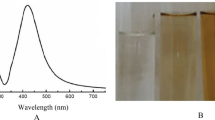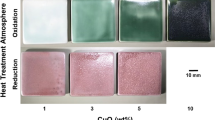Abstract
Microbial colonization has a relevant impact on the deterioration of stone materials with consequences ranging from esthetic to physical and chemical changes. Avoiding microbial growth on cultural stones therefore represents a crucial aspect for their long-term conservation. The antimicrobial properties of silver nanoparticles (AgNPs) have been extensively investigated in recent years, showing that they could be successfully applied as bactericidal coatings on surfaces of different materials. In this work, we investigated the ability of AgNPs grafted to Serena stone surfaces to inhibit bacterial viability. A silane derivative, which is commonly used for stone consolidation, and Bacillus subtilis were chosen as the grafting agent and the target bacterium, respectively. Results show that functionalized AgNPs bind to stone surface exhibiting a cluster disposition that is not affected by washing treatments. The antibacterial tests on stone samples revealed a 50 to 80 % reduction in cell viability, with the most effective AgNP concentration of 6.7 μg/cm2. To our knowledge, this is the first report on antimicrobial activity of AgNPs applied to a stone surface. The results suggest that AgNPs could be successfully used in the inhibition of microbial colonization of stone artworks.






Similar content being viewed by others
References
Aherne D, Ledwith DM, Gara M, Kelly JM (2008) Optical properties and growth aspects of silver nanoprisms produced by a highly reproducible and rapid synthesis at room temperature. Adv Funct Mater 18:2005–2016
Anagnostopoulos C, Spizizen J (1961) Requirements for transformation in Bacillus subtilis. J Bacteriol 61:741–746
Chaloupka K, Malam Y, Seifalian AM (2010) Nanosilver as a new generation of nanoproduct in biomedical applications. Trends Biotechnol 28:580–588
Choi O, Hu Z (2008) Size dependent and reactive oxygen species related nanosilver toxicity to nitrifying bacteria. Environ Sci Technol 42:4583–4588
De Leo F, Iero A, Zammit G, Urzi CE (2012) Chemoorganotrophic bacteria isolated from biodeteriorated surfaces in cave and catacombs. Int J Speleol 41:125–136
Dei L, Mauro M, Baglioni P, Manganelli Del Fa C, Fratini F (1999) Growth of crystal phases in porous media. Langmuir 15:8915–8922
Egger S, Lehmann RP, Height MJ, Loessner MJ, Schuppler M (2009) Antimicrobial properties of novel silver-silica nanocomposite material. Appl Environ Microbiol 75:2973–2976
Fajardo-Cavazos P, Nicholson W (2006) Bacillus endospores isolated from granite: close molecular relationships to globally distributed Bacillus spp. from endolithic and extreme environments. Appl Environ Microbiol 72:2856–2863
Falletta E, Bonini M, Fratini E, Lo Nostro A, Pesavento G, Becheri A, Lo Nostro P, Canton P, Baglioni P (2008) Clusters of poly(acrylates) and silver nanoparticles: structure and applications for antimicrobial fabrics. J Phys Chem C 112:11758–11776
Feng QL, Wu J, Chen GQ, Cui FZ, Kim TN, Kim JO (2000) A mechanistic study of the antibacterial effect of silver ions on E. coli and S. aureus. J Biomed Mater Res 52:662–668
Gaylarde C, Silva MR, Warscheid T (2003) Microbial impact on building materials: an overview. Mater Struct 36:342–352
Jung WK, Koo HC, Kim KW, Shin S, Kim SH, Park YH (2008) Antibacterial activity and mechanism of action of the silver ion in S. aureus and E. coli. Appl Environ Microbiol 74:2171–2178
Kim JS, Kuk E, Yu KN, Kim JH, Park SJ, Lee HJ, Kim SH, Park YK, Hwang CY, Lee YS, Jeong DH, Cho MH (2007) Antimicrobial effects of silver nanoparticles. Nanomed Nanotechnol Biol Med 3:95–101
Knetsch MLW, Koole LH (2011) New strategies in the development of antimicrobial coatings: the example of increasing usage of silver and silver nanoparticles. Polymers 3:340–366
Kobayashi Y, Katakami H, Mine E, Nagao D, Konno M, Liz-Marzan LM (2005) Silica coating of silver nanoparticles using a modified Stöber method. J Colloid Interface Sci 283:392–396
Lok CN, Ho CM, Chen R, He QY, Yu WY, Sun H, Tam PKH, Chiu JF, Che CM (2007) Silver nanoparticles: partial oxidation and antibacterial activities. JBIC J Biol Inorg Chem 12:527–534
Lok CN, Ho CM, Chen R, He QY, Yu WY, Sun H, Tam PKH, Chiu JF, Che CM (2006) Proteomic analysis of the mode of antibacterial action of silver nanoparticles. J Proteome Res 5:916–924
McNamara C, Mitchell R (2005) Microbial deterioration of historic stone. Front Ecol Environ 3:445–451
Morones JR, Elechiguerra JL, Camacho A, Holt K, Kouri JB, Ramires JT, Yacaman MJ (2005) The bactericidal effect of silver nanoparticles. Nanotechnology 16:2346–2353
Mosquera MJ, Santos DM D l, Montes A, Valdez-Castro L (2008) New nanomaterials for consolidating stone. Langmuir 24:2772–2778
Niitsoo O, Couzis A (2011) Facile synthesis of silver core-silica composite nanoparticles. J Colloid Interface Sci 354:887–890
Ozy F, Guden M, Uzel A, Karaboz I, Akil O, Bulut H (2010) Antimicrobial activity of TiO2-coated orthodontic ceramic brackets against Streptococcus mutans anc Candida albicans. Biotechnol Bioprocess Eng 15:680–685
Page K, Palgrave RG, Parkin I, Wilson M, Savin SLP, Chadwick AV (2007) Titania and silver-titania composite films on glass-potent antimicrobial coatings. J Mater Chem 17:95–104
Pal S, Tak YK, Song JM (2007) Does the antibacterial activity of silver nanoparticles depend on the shape of the nanoparticle? A study of the Gram-negative bacterium E. coli. Appl Environ Microbiol 73:1712–1720
Panacek A, Kvitek L, Prucek R, Kolar M, Vecerova R, Pizurova N, Sharma VK, Nevecna T, Zboril R (2006) Silver colloid nanoparticles: synthesis, characterization, and their antibacterial activity. J Phys Chem B 110:16248–16253
Pinna D, Salvadori B, Galeotti M (2012) Monitoring the performance of innovative and traditional biocides mixed with consolidants and water-repellents for the prevention of biological growth on stone. Sci Total Environ 423:132–141
Raccomandazioni NorMal (1993) AA VV Raccomandazioni NorMal 43/93, Misure colorimetriche strumentali I superfici opache. CNR-ICR, Roma
Rai M, Yadav A, Gade A (2009) Silver nanoparticles as a new generation of antimicrobials. Biotechnol Adv 27:76–83
Scheerer S, Ortega-Morales O, Gaylarde C (2009) Microbial deterioration of stone monuments—an update overview. Adv Appl Microbiol 66:97–139
Silver S (2003) Bacterial silver resistance: molecular biology and uses and misuses of silver compounds. FEMS Microbiol Rev 27:341–353
Sondi I, Salopek-Sondi B (2004) Silver nanoparticles as antimicrobial agent: a case study on E. coli as a model for Gram-negative bacteria. J Colloid Interface Sci 275:177–182
Stassi A, Zanardini F, Cappitelli F, Schiraldi A, Sorlini C (1998) Calorimetric investigations on the metabolism of Bacillus strains isolated from artistic stoneworks. Ann Microb (Milan) 48:111–120
Warscheid T, Braams J (2000) Biodeterioration of stone: a review. International Biodeterioreation Biodegrad 46:343–368
Xu K, Wang JX, Kang XL, Chen JF (2009) Fabrication of antibacterial monodispersed Ag-SiO2 core-shell nanoparticles with high concentration. Mater Lett 63:31–33
Yao N, Yeung KL (2011) Investigation of the performance of TiO2 photocatalytic coatings. Chem Eng J 167:13–21
Acknowledgments
CSGI and Ministry for Education and Research (MIUR, PRIN2009-2009P2WEAT) are gratefully acknowledged for financial support. M.B. thanks the EU for financial support under the Marie Curie Actions - European Reintegration Grants (FP7-PEOPLE-2009-RG, Project number: 249319, SUPRACRYST). The authors also thank dr. Nicole Bonelli, CSGI, for the assistance with colorimetric measurements.
Author information
Authors and Affiliations
Corresponding author
Additional information
Responsible editor: Gerald Thouand
Electronic supplementary material
Below is the link to the electronic supplementary material.
ESM 1
(DOCX 909 KB)
Rights and permissions
About this article
Cite this article
Bellissima, F., Bonini, M., Giorgi, R. et al. Antibacterial activity of silver nanoparticles grafted on stone surface. Environ Sci Pollut Res 21, 13278–13286 (2014). https://doi.org/10.1007/s11356-013-2215-7
Received:
Accepted:
Published:
Issue Date:
DOI: https://doi.org/10.1007/s11356-013-2215-7




